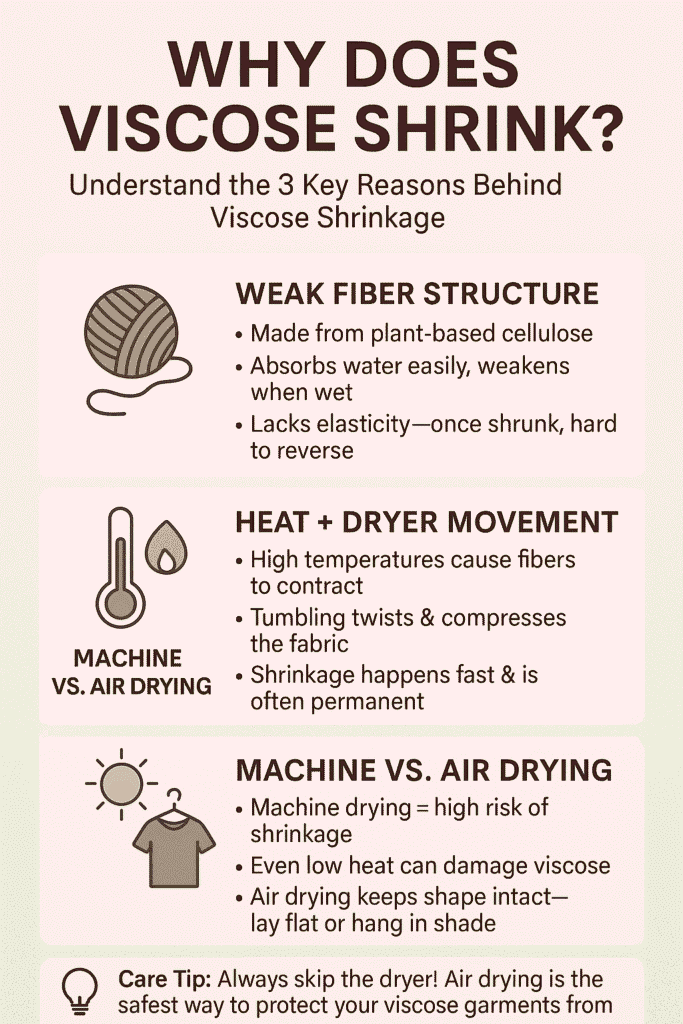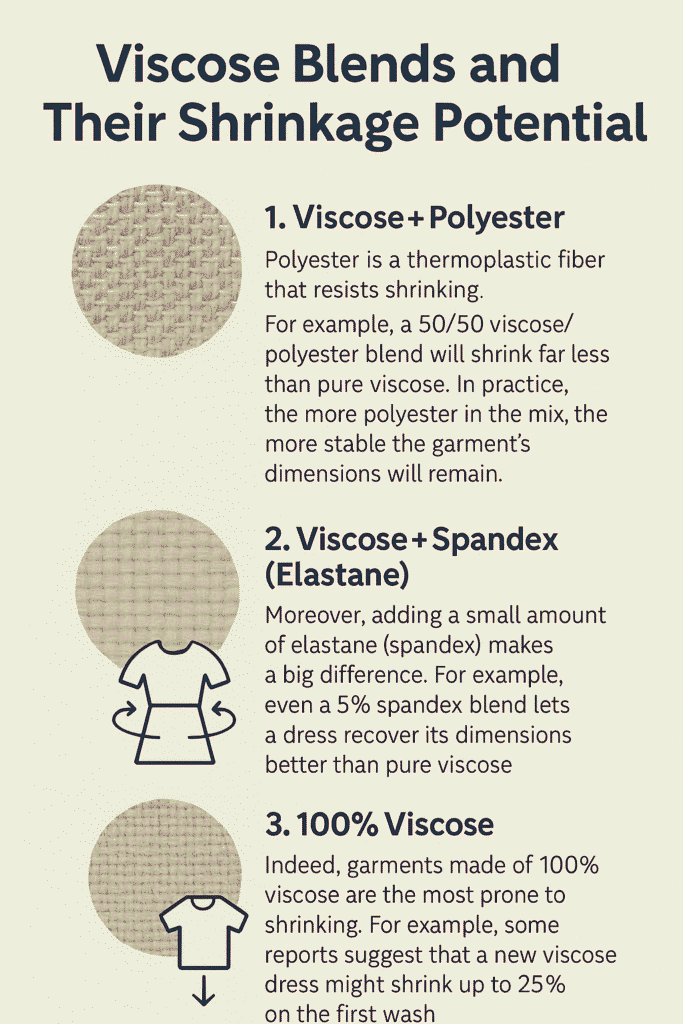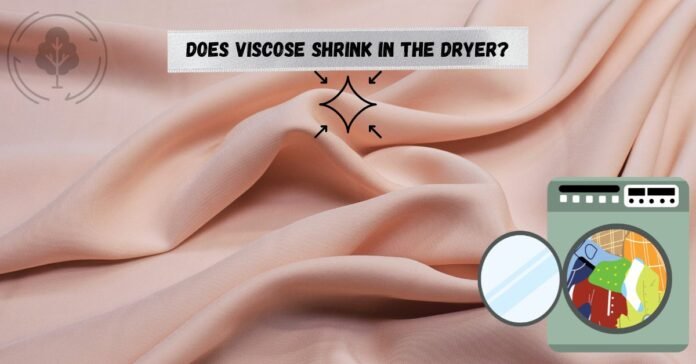Introduction to Viscose Fabric-
Viscose is type of rayon that is made out of wood pulp or plant cellulose. Interestingly, it is very smooth; has a silky touch which is the reason why it is known as artificial silk. Moreover, the viscose is valued according to the softness, lightness, and breathableness. Consequently, it can be comfortable to put on during hot seasons by most of the people. Actually, viscose drapes well and dyes well. Thus, it is widely applied to dresses, blouses, lining and domestic fabrics such as curtains and beddings. In addition, viscose is even luxurious at prices so low as compared to natural silk. Due to this reason, the combination of its attractiveness and price range and the variety of its uses, make it more prominent in the daily fashion and interior design. Now the question “does viscose shrink in the dryer?” is answered in the article.
Does Viscose Shrink in the Dryer?
Yes, viscose can shrink in the dryer—and often does. There are chances of shrinking of viscose in the dryer. Its fibers that are made of cellulose soak in the moisture and on exposure to the heat, they shrink. Indeed, experts caution that the dryer should not be set to high temperatures since it will cause a shrinking effect on viscose garments. To give an example, 100% viscose product may shrink by up to 25% when mishandled during drying. A shrinkage of 3 to 5% will affect the fit of a garment even in a noticeable way.
In comparison, cotton, which also shrinks during heat, is stable than the viscose. Polyester on the other hand shrinks so little. Silk is also gentle; it may also contract when put in a high heating environment. Finally, viscose tends to shorten more than most other materials, so it should be taken special attention when drying it.
Why Does Viscose Shrink in the dryer?

Fiber Structure and Wet Strength
In particular, the production of viscose occurs through a chemical regeneration of plants cellulose. This implies that it originates to be wood pulp and is refined into fibers. Notably, viscose has significantly less wet strength as opposed to natural cotton. In water the fibers swell up making them weak and thus can stretch or break easily. Concisely, the structure of the regenerated viscose is not that stable as the cotton. Such weak state contributes to the reasons why wet viscose may shrink a lot when drying out or being washed out.
Heat and Tumble Effects
Cloths made of viscose fibers are highly responsive to hot temperatures. Hot water or warm dryer air makes them dry up. High temperatures while washing or drying viscose fibers cause them to shrink and thereby reduce the size of the garment. Also the tumbling action of the dryer shakes the fabric. This vibrational movement can easily damage the weave, or lead to pilling. So, heat from a dryer and friction too can cause viscose garments to shrink and lose their shape much obviously than gentle air drying could.

Tumble Dry vs. Air Dry
Conversely to that, machine-drying uses heat and motion that viscose cannot bear. On the other side, air drying does not involve heat and agitation. For example, one authority source actually discourages tumble drying viscose. Hanging or placing the item flat allows it to dry slowly and keep its shape while dried. At the end of the day, the most reliable method of drying viscose clothing is air-drying.
How to Prevent Viscose from Shrinking in the Dryer
- The first one to check is the care label. First of all, in every garment, there are instructions to how things should be done. When there are dry clean only tags, then you need to avoid the washing machine and dry cleaner altogether.
- Turn on low heat settings or air-dry. Also, rinse viscose using cold water in a delicate mode. Then tumble-dry on a low set or no-heat setting. A number of specialists even recommend no drying heat at all of viscose.
- Take out when wet, and re-mold. Then pull out the item as immediately as the cycle finishes. Set the wet cloth at rest or hang it up to dry by gently stretching it back to what it used to be.
- Avoid over-drying. Do not also leave viscose to dry up in the machine. Additional shrinkage is possible through over-drying. When the dryer is stopped prematurely it can help avoid over shrinkage and fabric strain.
- Try other drying techniques. Lastly, avoid using the dryer in case it is possible. Air dry viscose or place flat, on a towel. This mild procedure minimizes the chances of shrinkage to a great extent.
Can You Unshrink Viscose?
Sometimes a viscose item does shrink by accident. The good news is, you can often relax and reshape the fibers. Below are a few DIY methods to help stretch a shrunken viscose garment back toward its original size.
Soaking in Conditioner
For instance, one of the popular tricks is to soak the shrunken garment into a mild conditioning solution. Boil some water at room temperature and put a small amount of hair conditioner or baby shampoo, gentle kinds. The softening agents will relieve viscosity of the fibers viscose. Let the piece soak for a few minutes only (not more than 5 minutes). Then squeeze out most of the water (do not wring it). Lay the garment on a towel flat on your lap and starting at the top tie and slowly work out. This technique works because the conditioner relaxes the fibers so they are much simpler to pull back into place.
Gentle Stretching
In the case of slightly shrunken items, there might not be any product that you require. When they are worn out, wash and dry them by leaving the viscose item wet and laying it out in a towel. Then with your hands pull in a slow way and remake the wet piece of cloth. Stretch a little at a time from the center, all the way out round. Take your time and do not strain much because the fibers can tear. When the viscose is allowed to dry it falls into the extended form, and recovers at least part of its normal dimensions.
Using Steam or a Warm Iron
Another way to relax viscose fibers that has a steamer or iron. Hold the garment inside out with its hem and use steam to the fabric. Some care directions recommend carefully pulling the fabric as you steam so that the moisture does miracles to the stretch. Keep working until the wrinkles and shrinkage begin to release. Next turn the item right side out, hang it up let it air and dry on a flat surface or hanger .
Proper Washing & Care Tips for Viscose
- Hand wash vs. machine wash (delicate cycle)
- Hand wash is the safest choice. Use cold or lukewarm water and mild detergent. If you prefer machine washing, select the delicate cycle with a laundry bag.
- Best detergents for viscose
- Use mild liquid detergents that are suitable for delicate fabrics. Avoid bleach or fabric softeners that contain harsh chemicals. These can weaken the fibers or cause fading.
- Avoid harsh chemicals and excessive wringing
- Never twist or wring out viscose items. This will distort their shape. Instead, gently squeeze them between two towels to remove excess water.
Common Myths About Viscose Care
Myth: Viscose is similar to cotton it can resist hot temperatures. Fact: not true. Viscose is a cellulose material but weaker, in wet condition, as compared to cotton. As an example, it has been found that the viscose fibers lose strength when they are exposed to water and heat. As compared to cotton, viscose is going to shrink miles more in high temperatures.
Myth: All the viscose blends shrink equally. Fact: Shrinkage is a blend dependent factor. An example of the hyping is a combination of viscose and polyester/elastane to make viscose more stable. Viscose/polyester fabrics shrink less compared to the 100 percent viscose.
Myth: Viscose has to be dry-cleaned. Fact: Not at all. Most of the viscose materials could be washed by hand or through a gentle machine cycle. Very delicate pieces can go to dry cleaners but normally washing carefully at home is quite ok as long as the label permits.
Viscose Blends and Their Shrinkage Potential

1. Viscose + Polyester
Polyester is a thermoplastic fiber that resists shrinking. In one study, 100% polyester fabric showed virtually no shrinkage, while 100% cotton shrank a lot under the same conditions. As a result, adding polyester to viscose means the polyester threads take up heat without contracting. For example, a 50/50 viscose/polyester blend will shrink far less than pure viscose. In practice, the more polyester in the mix, the more stable the garment’s dimensions will remain.
2. Viscose + Spandex (Elastane)
Moreover, adding a small amount of elastane (spandex) makes a big difference. Elastane adds elasticity to viscose fabrics, which helps garments snap back into shape. For example, even a 5% spandex blend lets a dress recover its dimensions better than pure viscose. Therefore, viscose-spandex blends fit snugly but hold their shape, so shrinkage problems are much less noticeable in these stretchy fabrics.
3. 100% Viscose
Indeed, garments made of 100% viscose are the most prone to shrinking. Because there are no other fibers to provide stability, pure viscose items can change size dramatically. For example, some reports suggest that a new viscose dress might shrink up to 25% on the first wash. In practice, always assume that 100% viscose will lose some length or width in a hot dryer, so extra caution is needed.
Expert Tips for Long-Lasting Viscose Clothing
The life of viscose garments may significantly be prolonged through proper storage and handling. As an example, store viscose garments in a dry cool area free of moisture. Further, fabric should be avoided under weight by use of padded or wide hangers. Alternatively, viscose items can be folded so as to relieve tension on the seams and shoulders. Do not keep pieces of viscose very long on hangers, since moisture or weight may change the shape.
Low heat and steam should always be utilized when ironing. As an example one care guide recommends that a hot iron be used on the backside with steam to make creases disappear. This not only removes the wrinkles, but it does not smooth the soft texture. A low-heat steamer (if you have one) can also be applied to the lightly damp material with the aim of removing minor wrinkles.
Lastly, there is such time as one should seek the help of experts. In case a viscose has been made overly delicate, or ornamented, or even marked as Dry Clean Only, it will probably be safer to have it cleaned by professionals. One scientist indicates that in doubt always use dry cleaning or professional steam treatments, because of no clear way to fix it. With these cautious methods of the storage to the cleaning, you will prolong the life of your viscose items way more.
Conclusion to “Does viscose shrink in the dryer?”-
Finally, viscose needs extreme light treatment. During tumble drying it will wring viscose fibers hence avoid tumble drying Nor should anything be dried under high heat because fiber will shrink. Rather, it is always advisable to take wet viscose clothing out of the machine and leave them horizontally to dry or hang to air dry. One such clothing label cautions to dry on a line, tumble drying which may produce shrinkage of viscose up to 10 percent. Shrinkage is reduced by using cool water, little or no heat and reshaping when damp. Finally, always consult the care label and preserve your viscose clothes by using soft techniques and retain them in the finest form.
Read More>> Viscose production process.
FAQs
In general, it’s not recommended. Tumble-dry cycles can rapidly shrink viscose. If you must use
a dryer, use a no-heat or air-dry setting and check the garment frequently. For example, one care guide warns that regular tumble-drying can shrink viscose by up to 10%. As a result, the safest approach is to air-dry whenever possible.
Typically, yes. Viscose fibers are much weaker when wet than cotton, so they tend to shrink more under heat. In practice, viscose often comes out of a hot wash or dryer smaller than a comparable cotton item.
Essentially, by removing moisture without heat. After washing, gently squeeze or roll the item in a towel to remove excess water. For instance, one guide suggests using a towel to soak up moisture. Then lay the garment flat or hang it in a well-ventilated, shaded spot. A steady breeze (or a fan on low) will speed drying without the heat that causes shrinkage.
